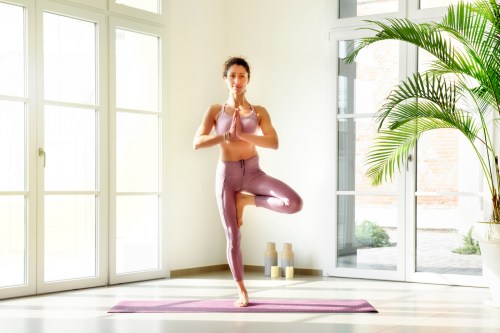The secret to stability in yoga lies in your nether region, and it’s called mula bandha
Yoga experts explain what the mula bandha is, plus how to engage it for a stronger, more stable yoga practice. Here's what to know.

People who haven’t tried yoga often sneer at the practice for being too easy. Once they actually get onto the mat, though, they quickly realize that yoga is incredibly challenging—mainly because of the amount of stability required in order to hold the many poses that you flow through. While having good strength and balance helps, the secret to having strong stability in yoga also lies in something called the mula bandha.
In Sanskrit, the ancient language of India, “mula” means root and “bandha” means lock or binding, according to Haley Steinhauser, a yoga instructor based in New York. “Bandha can mean a physical lock, but also the more metaphorical channeling of energy,” she says, noting that it’s similar to a chakra. Since this one involves your root, it actually lies in your, er, nether region. “Mula bandha is engaging your pelvic floor, the area between your genitals and your anus, which will change your entire practice,” she says.
Essentially, engaging your mula bandha as you move through poses will give you more control and stability in your poses. Kyle Miller, a Los Angeles-based yoga instructor and co-founder of Love Yoga, says that the bandhas (there are two others in your body—one in your diaphragm and one in your throat) are powerful tools for controlling the movement of energy in the body. “When you’ve seen people weightlessly float on their mat, it’s a bandha mastery thing,” she says. “They’re light as a feather with no energy pulling them down.”
Steinhauser adds that focusing on your mula bandha brings your practice inward, and works as an internal adjustment that brings you more stability and vigor. “The stability it brings in your body will make your movements safer,” she says. “If you couldn’t hold tree pose before, I promise you’ll be able to once you start practicing mula bandha. You’ll also notice that once this root of your body is turned on, you’ll feel much more energized in your asanas.”
As for how to actually use the mula bandha when you flow, the key involves focusing on your muscles. It’s like when you engage your core in an ab workout, for instance. “The first part is finding it, which we learned in my training in three stages,” says Steinhauser. “One is to squeeze your anus, then squeeze your genitals—which is like a kegel for women—and then focus on the space between the two. Part of the challenge of incorporating this is understanding how to activate it.” It might sound strange, but Miller stresses that it becomes very subtle once you master the technique. “It’s like trying to hold your pee in,” she says. “It’s a subtle engagement and lift.”
Her tip? Sit down cross-legged or kneeling and let your awareness settle at the ground to your pelvic floor at the base of the spine. “Use your awareness to engage the muscles down there, and after a while, it’ll become easy to find and isolate.” So try focusing on your, er, underparts to upgrade your yoga practice.
Try it in this beginner yoga flow, courtesy of Val Verdier:
Sign Up for Our Daily Newsletter
Get all the latest in wellness, trends, food, fitness, beauty, and more delivered right to your inbox.
Got it, you've been added to our email list.










